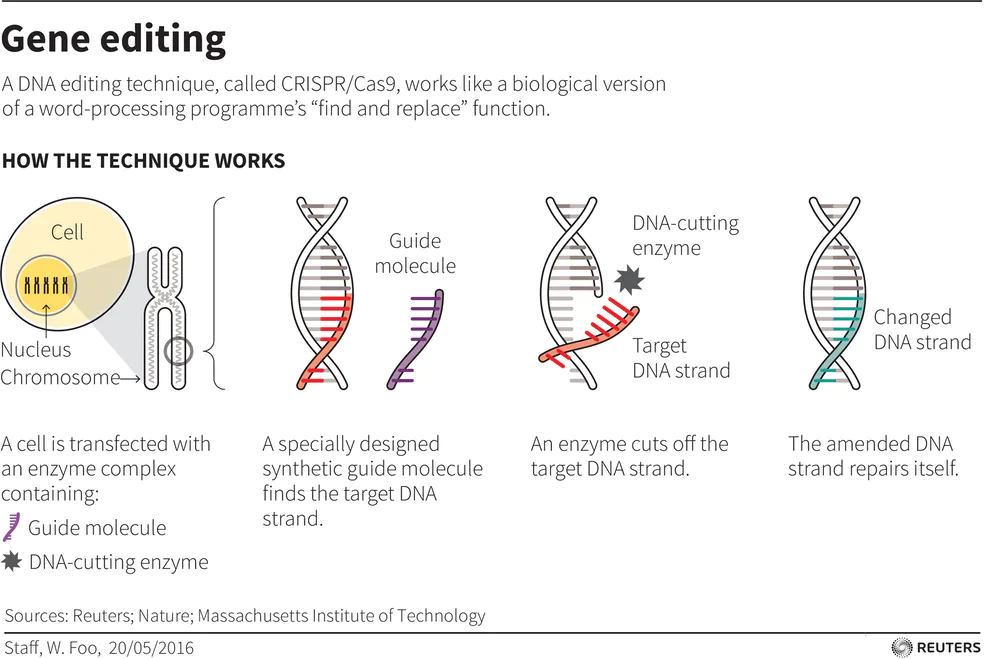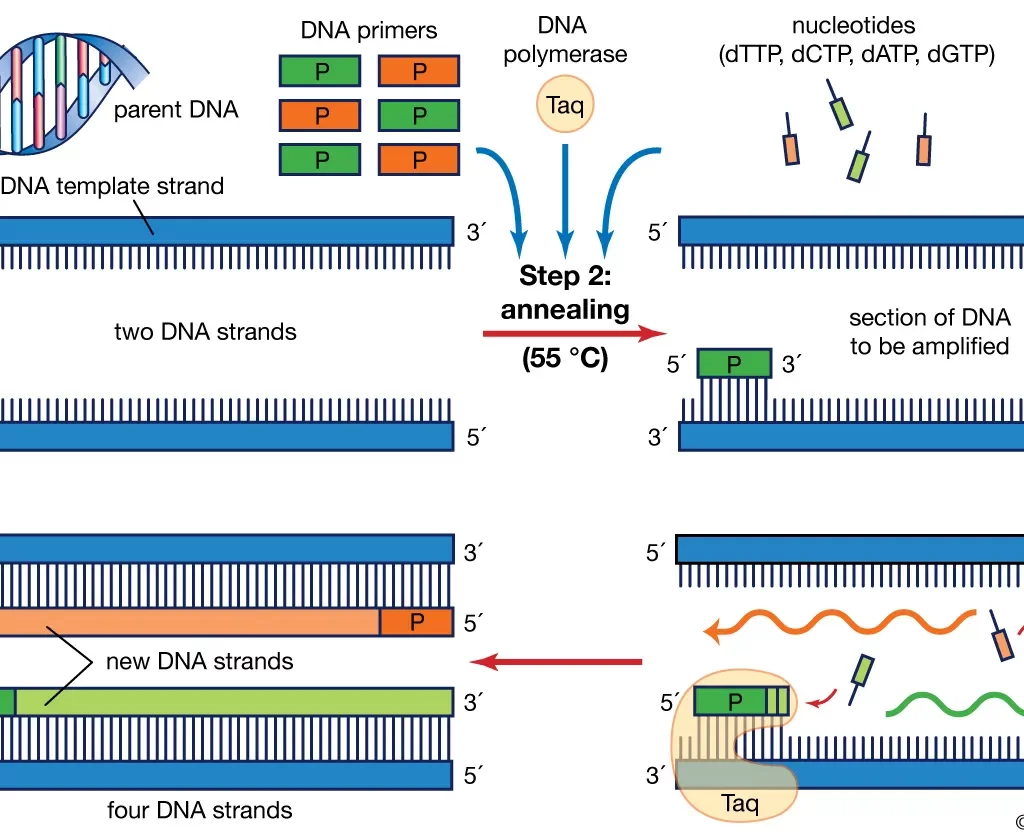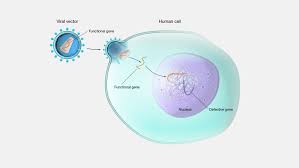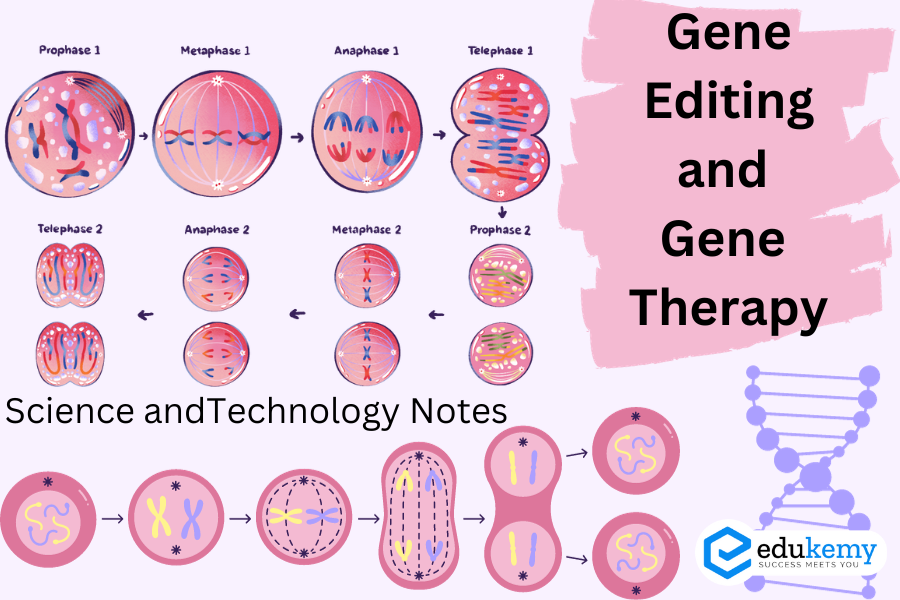

Gene editing is a powerful and revolutionary biotechnological technique that allows scientists to precisely modify the DNA of living organisms. It enables the addition, deletion, or replacement of specific DNA sequences within the genome, the genetic material that contains an organism’s hereditary information. The most widely used gene editing technology is known as CRISPR-Cas9.
CRISPR-Cas9, which stands for Clustered Regularly Interspaced Short Palindromic Repeats-CRISPR associated protein 9, is a system borrowed from the bacterial immune system. It has been adapted for use in a wide range of organisms, including plants, animals, and even human cells. The CRISPR-Cas9 gene editing process involves the following steps:
- Guide RNA Design: A small RNA molecule, known as guide RNA, is designed to match the target DNA sequence that needs to be edited.
- Cas9 Nuclease: The Cas9 protein acts as a pair of “molecular scissors” that can cut the DNA at the specific target site guided by the guide RNA.
- DNA Modification: Once the Cas9 protein cuts the DNA at the target site, the cell’s natural repair mechanisms come into play. Depending on the desired outcome, the repair process can result in either the deletion, insertion, or replacement of specific DNA segments.
- A decade ago, scientists in Germany and the US discovered a technique that allowed them to ‘cut’ DNA strands and edit genes.
- For agriculture scientists this process allowed them to bring about desired changes in the genome by using site-directed nuclease (SDN) or sequence-specific nuclease (SSN).
- Nuclease is an enzyme that cleaves through nucleic acid — the building block of genetic material.
- For agriculture scientists this process allowed them to bring about desired changes in the genome by using site-directed nuclease (SDN) or sequence-specific nuclease (SSN).
- Advanced research has allowed scientists to develop highly effective clustered regularly interspaced palindromic repeat (CRISPR) -associated proteins-based systems.
- This system allows for targeted intervention at the genome sequence.
- This tool has opened up various possibilities in plant breeding. Using this tool, agricultural scientists can now edit the genome to insert specific traits in the gene sequence.
- Depending on the nature of the edit that is carried out, the process is divided into three categories — SDN 1, SDN 2, and SDN 3.
- SDN1 introduces changes in the host genome’s DNA through small insertions/deletions without the introduction of foreign genetic material.
- In the case of SDN 2, the edit involves using a small DNA template to generate specific changes.
- Both these processes do not involve alien genetic material and the end result is insisting

Contents
- 0.1 Applications of Gene Editing
- 0.2 Stem Cells :
- 0.3 Growing Human Organs in Animal Body:
- 0.4 Polymerase Chain Reaction (PCR)
- 0.5 What Is CRISPR-Cas9?
- 0.6 CRISPR-Cas9:
- 0.7 Nuclear Transfer Techniques:
- 0.8 Gene Therapy
- 0.9 Gene Delivery:
- 0.10 Genetic Disorders:
- 1 Frequently Asked Questions (FAQs)
Applications of Gene Editing
Gene editing has numerous applications across various fields, including:
Medical Applications:
Gene editing holds great promise in the treatment of genetic diseases. It allows scientists to correct or remove faulty genes responsible for inherited disorders. Additionally, it can be used to engineer immune cells to better target and destroy cancer cells.
Agriculture:
Gene editing can be used to create crops with enhanced nutritional value, improved resistance to pests and diseases, and increased yields. This technology has the potential to address global food security challenges and reduce the need for harmful agricultural chemicals.
Conservation:
Gene editing may be employed to help conserve endangered species by addressing genetic problems that threaten their survival, enhancing their reproductive success, or making them more resilient to changing environmental conditions.
Basic Research:
Gene editing is widely used in scientific research to study gene function and understand the genetic basis of various biological processes and diseases.
While gene editing offers numerous possibilities and potential benefits, it also raises ethical and societal considerations. Some concerns include the possibility of unintended consequences, the risk of off-target effects, and the potential for misuse or unequal access to gene editing technologies.
Stem Cells :
- The smallest functional unit of life is called the Cell.
- These cells develop to form tissues which in turn develop to form organs.
- Stem cells are basically undifferentiated, primitive cells that have the potential to develop into many different types of cells like those in muscles, kidneys, liver, etc.
- Stem cell therapy has shown the potential to cure many severe ailments. It is touted as the future of medical treatments.
- They have proved effective in the treatment of blood disorders, immune disorders, metabolic problems, & other organ-degenerated diseases.
Growing Human Organs in Animal Body:
Recently Japanese researchers have successfully developed functional mouse kidneys inside rats using stem cells. This could be replicated in Humans.
Source of Stem Cells:
- Bone marrow, Umbilical cord blood, Adipose tissue, Allografts, Amniotic fluid, etc.
- Based on Source: Types of stem Cells:
- Embryonic Stem Cells (ESCs)
- Adult/Somatic stem cells
Adult stem cells include:
- Hematopoietic Stem cells (HSCs), Mesenchymal Stem Cells, Neural stem cells, Epithelial Stem cells, Skin stem cells, Induced pluripotent stem cells.
- Induced pluripotent stem cells (iPS): Scientists create these in a lab, using skin cells and other tissue-specific cells. These cells behave in a similar way to embryonic stem cells, so they could be useful for developing a range of therapies.
- These cells are derived from the patient themselves, so less likely to be rejected.
Cell Potency:
Refers to the varying ability of stem cells to differentiate into specialized cell types.
Cells with the greatest potency can generate more cell types than lower-potency cells.
Hierarchy of Cell Potency:
Totipotent Stem Cells: Stem cells can give rise to any of 220 cell types found in the embryo as well as extra-embryonic cells(placenta).
Pluripotent Stem Cells: can give rise to all cell types of the body (but not the placenta).
Multipotent Stem Cells: can develop a limited number of cell types in a particular lineage.
Unipotent Stem Cells: give rise to cells of their own type along a single lineage.
DNA Profiling:
DNA profiling is the process where a specific DNA pattern, called a profile, is obtained from a person or sample of bodily tissue.
It is a forensic technique in criminal investigations, comparing criminal suspects’ profiles to DNA evidence so as to assess the likelihood of their involvement in the crime.
It is also used in parentage testing, to establish immigration eligibility, and in genealogical and medical research.
Short Tandem Repeats (STRs):
One of the current techniques for DNA profiling uses polymorphisms called STRs.
These are regions of non-coding DNA that contain repeats of the same nucleotide sequence. Ex: GATAGATA
Genetic Disorders
A genetic disorder is a disease that is caused by a change, or mutation, in an individual’s DNA sequence.
These mutations can be due to an error in DNA replication or due to environmental factors, such as cigarette smoke & exposure to radiation, which cause changes in the DNA sequence.
The three main categories are:
Single gene disorders:
- disorders caused by defects in one particular gene, often with simple and predictable inheritance patterns. Ex: Huntington’s disease, Cystic fibrosis.
Chromosome disorders:
- disorders resulting from changes in the number or structure of the chromosomes. Ex: Down’s syndrome, which results from an extra chromosome 21.
Multifactorial disorders (complex diseases):
- disorders caused by changes in multiple genes, often in a complex interaction with environmental & lifestyle factors such as diet or cigarette smoke.
Zinc-Finger Nucleases (ZFN)
- The DNA-binding part of ZFNs is made of zinc-finger proteins, which each binds to about three DNA bases. Different combinations of zinc-finger proteins bind to different sequences of DNA.
- The nuclease part of ZFNs is normally a FokI nuclease, which cuts the DNA.
| Gene Silencing | · Gene silencing is the regulation of gene expression in a cell to prevent the expression of a certain gene.· When genes are silenced, their expression is reduced. Ex: the researchers designed two small RNA molecules that silence the fungal genes that produce aflatoxin in Groundnuts.· When genes are knocked out, they are completely erased from the organism’s genome and thus, have no expression. |
| Applications: | · Specific gene silencing using RNAi in cell culture.· Cancer treatments· RNA interference has been used for applications in biotechnology.· Useful in epigenomic analysis and clinical application of molecular diagnosis.· Neuro-degenerative disorders treatment. |
Polymerase Chain Reaction (PCR)
Polymerase chain reaction (abbreviated PCR) is a laboratory technique for rapidly producing (amplifying) millions to billions of copies of a specific segment of DNA, which can then be studied in greater detail. PCR involves using short synthetic DNA fragments called primers to select a segment of the genome to be amplified, and then multiple rounds of DNA synthesis to amplify that segment.

Polymerase chain reaction, PCR. So PCR dates back to the mid-1980s, which is more or less the time when the Human Genome Project was being considered and then started at the end of that decade. PCR has been really fundamental to so much of biology and biomedical research since then. Since we’re at the Genome Institute, it’s worth noting that it was a fundamental technology behind the early days of the Human Genome Project. And it has played an important role up till today. And it’s going to continue to play one for a long time, I suspect, although you never know — there’s always another groundbreaking technology.
What Is CRISPR-Cas9?
CRISPR-Cas9:
- CRISPR stands for ‘Clustered Regularly Interspaced Short Palindromic Repeats’
- It is the most common, cheap & efficient system used for genome editing.
- CRISPR is the DNA-targeting part of the system which consists of an RNA molecule, or ‘guide’, designed to bind to specific DNA bases through complementary base-pairing.
- Cas9 stands for CRISPR-associated protein 9, & is the nuclease part that cuts the DNA.
- The CRISPR-Cas9 system was originally discovered in Bacteria that use this system to destroy invading
Gene Therapy
- Technique to replace defective genes with healthy genes to treat genetic disorders.
- Artificial method that introduces DNA into the cells of the human body.
- First developed in 1972, but has limited success.
- Two types of gene therapy: Somatic gene therapy and germline gene therapy.
Mitochondrial Gene Therapy
Mitochondrial gene therapy is a specialized field within gene therapy that focuses on treating mitochondrial disorders caused by mutations in the mitochondrial DNA (mtDNA). Mitochondria are organelles found within cells that are responsible for generating energy in the form of adenosine triphosphate (ATP). When mutations occur in mtDNA, it can lead to dysfunctional mitochondria and a range of mitochondrial disorders.
Mitochondrial gene therapy aims to introduce healthy copies of mitochondrial genes into cells to overcome the effects of these mutations. Here are some key aspects of mitochondrial gene therapy:
Nuclear Transfer Techniques:
Mitochondrial gene therapy often involves transferring the nuclear DNA from an affected individual’s egg or embryo into a donor egg or embryo that has healthy mitochondria. This technique is known as nuclear transfer or mitochondrial replacement therapy.
a. Maternal Spindle Transfer (MST):
In this technique, the nucleus of the affected individual’s egg is transferred into a donor egg that has had its nucleus removed but retains healthy mitochondria. The resulting embryo contains nuclear DNA from the affected individual and healthy mitochondria from the donor.
b. Pronuclear Transfer (PNT):
PNT involves the transfer of the pronucleus from a fertilized egg of an affected individual into a donor egg that has had its pronucleus removed. This technique also results in an embryo with nuclear DNA from the affected individual and healthy mitochondria from the donor.
Genetic Modification:
Another approach to mitochondrial gene therapy involves directly modifying the mitochondrial DNA itself. This can be done using techniques such as mitochondrial-targeted gene editing or mitochondrial gene replacement.
a. Mitochondrial-targeted Gene Editing:
CRISPR-based gene editing tools can be used to specifically target and edit the mutated mitochondrial DNA within cells. This approach aims to correct or eliminate the specific mutations responsible for mitochondrial disorder.
b. Mitochondrial Gene Replacement:
This approach involves replacing the entire mutated mitochondrial DNA with healthy mitochondrial DNA from a donor. The donor mitochondrial DNA is introduced into cells, either through direct delivery or using viral vectors.
Ethical Considerations:
Mitochondrial gene therapy raises ethical considerations because it involves altering the germline (inheritable) mitochondrial DNA. This has led to discussions and debates regarding the safety, efficacy, and long-term consequences of such interventions.
Gene Therapy
Gene therapy is a technique that uses a gene(s) to treat, prevent or cure a disease or medical disorder. Often, gene therapy works by adding new copies of a gene that is broken, or by replacing a defective or missing gene in a patient’s cells with a healthy version of that gene.
Both inherited genetic diseases (e.g., hemophilia and sickle cell disease) and acquired disorders (e.g., leukemia) have been treated with gene therapy.
Gene therapy is an experimental medical technique that involves the use of genetic material to treat or prevent diseases at the genetic level. The primary goal of gene therapy is to correct or replace faulty genes responsible for causing diseases or disorders. This cutting-edge approach has the potential to provide cures or long-term treatments for genetic disorders that were previously considered incurable.

Key features and aspects of gene therapy include:
Gene Delivery:
In gene therapy, a functional copy of a gene is introduced into a patient’s cells to replace or compensate for a faulty gene. The functional gene can be delivered using various methods, such as viral vectors, liposomes, or direct injection.
Types of Gene Therapy:
There are two main types of gene therapy – somatic cell gene therapy and germline gene therapy. Somatic cell gene therapy involves targeting and correcting genes in specific body cells to treat the individual patient. Germline gene therapy aims to modify genes in reproductive cells, affecting not only the individual but also their offspring. As of now, germline gene therapy is considered ethically controversial and is not widely practiced due to safety and ethical concerns.
Ex Vivo and In Vivo Approaches:
Gene therapy can be conducted ex vivo or in vivo. Ex vivo gene therapy involves extracting cells from the patient, genetically modifying them outside the body, and then reintroducing the modified cells back into the patient. In vivo gene therapy directly delivers the therapeutic genetic material to the patient’s tissues or organs without removing cells from the body.
Genetic Disorders:
Gene therapy is particularly promising for treating genetic disorders caused by single gene mutations, such as cystic fibrosis, sickle cell anemia, hemophilia, and certain types of inherited blindness.
Cancer Treatment:
Gene therapy is also being explored as a potential treatment for cancer. Some approaches involve modifying a patient’s immune cells to target and destroy cancer cells more effectively.
Challenges:
Gene therapy faces several challenges, including the difficulty of targeting specific tissues or cells, potential immune responses to the gene therapy vectors, and the risk of unintended genetic changes.
Clinical Trials and Advancements:
Gene therapy is still in the experimental stage, with ongoing clinical trials to test its safety and effectiveness for various conditions. Some gene therapies have shown promising results and received regulatory approval for commercial use.
Ethical Considerations:
Gene therapy raises important ethical considerations related to safety, informed consent, equitable access to treatments, and the potential implications of germline gene editing.
Gene therapy holds immense potential to revolutionize medical treatments for genetic disorders and other diseases. As research progresses and technology advances, gene therapy is expected to play an increasingly significant role in personalized medicine and healthcare.
Frequently Asked Questions (FAQs)
1. What is gene editing, and how does it work?
Answer: Gene editing is a technology that allows scientists to modify the DNA of an organism. One of the most widely used gene editing techniques is CRISPR-Cas9, which acts like a pair of molecular scissors to cut the DNA at a specific location. Once the DNA is cut, the cell’s natural repair machinery kicks in, leading to the addition, deletion, or replacement of genetic material. This precise manipulation of genes enables researchers to study gene functions, correct genetic defects, and even engineer desired traits.
2. How does gene therapy differ from gene editing?
Answer: Gene therapy and gene editing are related concepts but differ in their approach. Gene therapy involves introducing, removing, or altering genetic material within a person’s cells to treat or prevent disease. This is typically done by introducing functional genes into the patient’s cells to replace or supplement defective genes. In contrast, gene editing is a more precise technique that directly modifies the DNA sequence. While gene therapy is often used to treat existing genetic disorders, gene editing can potentially cure diseases by directly correcting the underlying genetic mutations.
3. What are the ethical considerations associated with gene editing and gene therapy?
Answer: The ethical implications of gene editing and gene therapy are significant and include concerns about unintended consequences, inequality in access to these technologies, and the potential for “designer babies.” The ability to modify the human germline raises ethical questions about the permanence of genetic changes and their impact on future generations. There is an ongoing global debate about setting ethical guidelines and regulations to ensure responsible use of these technologies. Balancing the potential benefits with ethical considerations is crucial to harness the power of gene editing and gene therapy responsibly.
In case you still have your doubts, contact us on 9811333901.
For UPSC Prelims Resources, Click here
For Daily Updates and Study Material:
Join our Telegram Channel – Edukemy for IAS
- 1. Learn through Videos – here
- 2. Be Exam Ready by Practicing Daily MCQs – here
- 3. Daily Newsletter – Get all your Current Affairs Covered – here
- 4. Mains Answer Writing Practice – here
Visit our YouTube Channel – here

